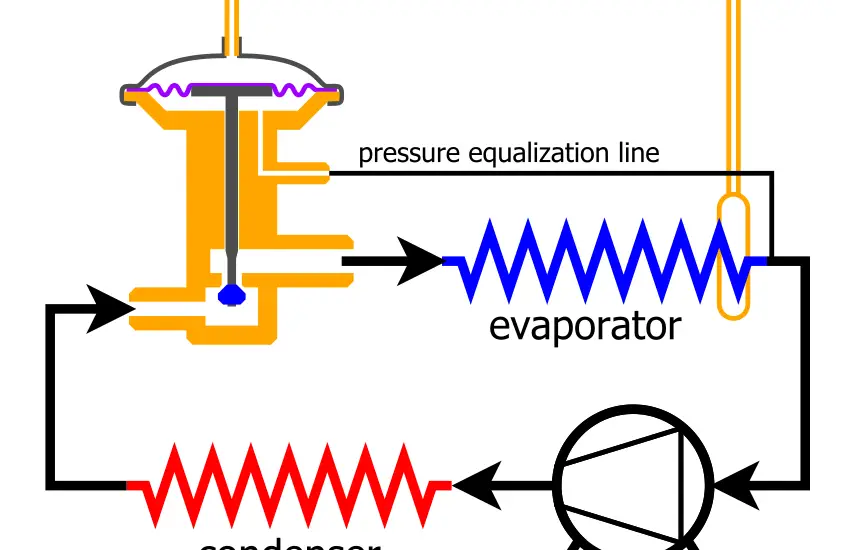If you own, operate, or are simply curious about TXV HVAC systems, understanding their fundamentals can be a game-changer in ensuring optimal functionality. This article will take you step by step through the workings of TXV HVAC systems, delineating every detail in a manner easy to grasp.

Table of Contents
What is TXV HVAC?
The TXV, or Thermostatic Expansion Valve, is an integral part of modern HVAC (Heating, Ventilation, and Air Conditioning) systems, fundamentally responsible for controlling the rate of refrigerant flow into the evaporator coil, a critical component in the cooling process. Let us further delve into what the TXV HVAC system is:
Temperature Regulation
A TXV works diligently to maintain a stable and comfortable temperature in your living or workspace. It does so by modulating the refrigerant flow; a crucial aspect in determining the temperature output.
Imagine having a system that smartly adjusts to deliver the right temperature always, that’s the efficiency a TXV brings to your HVAC system.
Enhancing Efficiency
The TXV plays a significant role in energy conservation. It dynamically adapts to the varying load conditions, meaning it regulates the refrigerant flow to match the cooling demand at any given time, ensuring that the system does not consume more energy than necessary.
This not only aids in reducing energy costs but also promotes a green and sustainable environment.
Protective Role
The TXV is like a guardian for your HVAC system; it ensures that the evaporator coil is neither underfed nor overfed with refrigerant, preventing issues such as coil flooding which can lead to system breakdowns.
It strikes the right balance, ensuring a longer and smoother operational lifespan for your HVAC system.
How Does TXV HVAC Work?
The working principle of a TXV HVAC system is built on a fairly straightforward mechanism. It modulates the flow of the refrigerant based on the cooling demand, which is determined by sensing the temperature of the refrigerant as it exits the evaporator coil. Let’s understand this in a step-by-step manner:
Sensing Bulb: Attached to the evaporator’s outlet, this component senses the refrigerant’s temperature, sending signals to the valve to make necessary adjustments.
Valve Adjustments: Depending on the signals received, the valve either increases or decreases the refrigerant flow to maintain a predetermined superheat level.
Superheat Explained: Superheat is the temperature rise observed in the refrigerant once it changes from liquid to vapor state. Maintaining an appropriate level is crucial to prevent liquid refrigerant from returning to the compressor, which can be damaging.
Check out these other articles...
Danfoss TXV Superheat Adjustment: In 8 Easy Steps
TXV Adjustment: Your Step-by-Step Guide
What is Superheat in Refrigeration: Comprehensive 411 Guide
How to Increase Superheat: A Step-by-step Guide
How to Lower Superheat: In 5 Easy Steps
Benefits of Using TXV HVAC in Cooling Systems
The utilization of a TXV in HVAC systems is increasingly becoming a norm due to the array of benefits it offers. Let’s take a detailed look at how incorporating a TXV can enhance your cooling systems:
Optimized System Efficiency
A TXV promotes optimized system functioning, by constantly adapting to changes in the cooling load, thus working towards sustaining the system’s peak efficiency level. It, therefore, aids in substantial energy saving, which is a boon not just for your pocket but also for the environment.
Stable Coil Temperatures
Fluctuations in temperature can be a nuisance and a TXV comes to the rescue by maintaining stable temperatures at the evaporator coil. It ensures a uniform and comfortable indoor climate, which means you will not experience those annoying sudden temperature drops or spikes anymore.
Stability in temperature also means less wear and tear, guaranteeing a long life for your system.
Improved Humidity Control
An underappreciated benefit of a TXV is its role in controlling humidity levels. By facilitating the optimal functioning of the evaporator coil, it aids in the dehumidification process.
This means not just a cooler, but a less humid and more comfortable environment, especially in geographical areas where humidity levels are generally high.
Extended System Life
By ensuring the correct amount of refrigerant flows into the evaporator coil at all times, it significantly reduces the strain on the compressor, the heart of the HVAC system.
Thereby averting issues like coil flooding and ensuring that your system enjoys a longer and healthier life.
Common Issues and How to Solve Them
Despite its benefits, a TXV HVAC system can face issues. Understanding these can be pivotal in ensuring a long-lasting system. Here, we discuss the common problems and their respective solutions:
Stuck TXV: Sometimes debris accumulates, causing the valve to stick. It is essential to clean the valve and the filter drier to restore functionality.
Insufficient Superheat: When there is too much refrigerant flow, it results in insufficient superheat. In such cases, check the bulb location and mounting to solve the issue.
Excessive Superheat: This problem arises when the TXV allows too little refrigerant, which could be due to undercharging or a clogged screen. Ensure to clear any blockages and maintain the correct refrigerant charge.